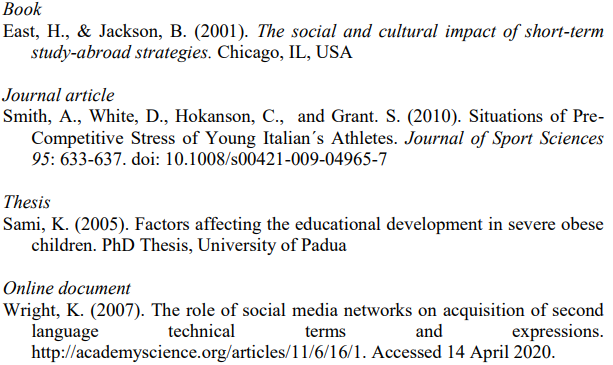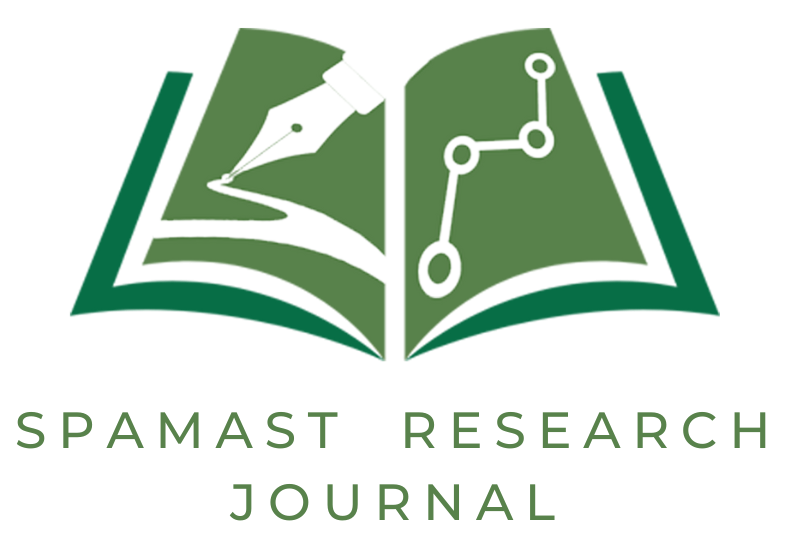Accepted languages
Manuscripts written in American or British English are accepted but not a mixture of these.
Content
A full research paper should have (depending on its type and purpose) the following sections:
Title
The title must be a concise and informative description of the research paper that accurately reflect the main scope and content of the manuscript. Title should not be 12-14 words only.
Name(s) of the author(s),
email(s) and affiliation(s)
The complete name of the authors, email address(s), and affiliation should be provided.
Abstract
This section should include a succinct, self-contained and powerful statement that describes the main objective of the study. The abstract must be approximately 250 words with no undefined abbreviations or unspecified references.
Key words (indexing terms):
a list of 4 to 6 significant keywords as index term is required.
Introduction
This section should comprise a description of the general framework, definitions and principles, primary issues and controversies, background information and context, etc.
Literature Review (Optional)
A section dedicated to the significant literature resources, consulted or employed, that contributed to the study. It surveys scholarly articles, books and other sources (e.g. dissertations, conference proceedings) relevant to a particular issue, area of research, or theory, providing a descriptions summary, and critical evaluation of each work. The purpose is to offer an overview of significant literature published on a topic.
Material and Methods
A section intended to contain a detailed description of all the methods, materials, collaborators and participants at the study. The protocols used for data acquisition, techniques and procedures, investigated parameters, methods of measurements and apparatus should described in sufficient detail to allow other scientists to understand, analyze and compare the results. The study subjects and participants should be described in terms of number, age and sex. The statistical methods should be described in detail to enable verification of the reported results. This section could contain a separated sub-section that comprises the explanation of the abbreviated terms used on the study.
Results and Discussion
A comparative or descriptive analysis of the study based on results, on previously studies, etc. The results should be presented in a logical sequences, given the most important findings first and addressing the stated objectives. The number of tables and figures should be limited to those absolutely needed to confirm or contest the premise of the study. The authors should deal only with new or important aspects of the results obtained. Material from the Results section should not be repeated, nor new material introduced. The relevance of the findings in the context of existing literature or contemporary practice should be addressed.
Conclusion
In this final section, the main find outs are concisely reiterated. Only conclusions supported by the study findings should be included.
Recommendations (Quantitative) & Implications (Qualitative)
This section contains theoretical and practical recommendations, further research ideas, new approaches, suggestions and concerns regarding potential social and cultural impacts, etc.
Acknowledgements (Optional)
People who contributed towards the work in any way for the manuscript preparation, but do not meet the criteria for authorship should be listed in acknowledgement section mentioning their contributions. These also include funding sources(s) of each author and describe the involvement of funding body or organization in the whole work. It is recommended to acknowledge the editor if any manuscript was revised for language corrections. Permissions should be obtained from all those who are acknowledged in this section.
References
The references section should followed the APA 6th edition.

Elements
- Figures and Tables – should have a numbered explanatory label posted below the graphic element. Each figure and table should have a descriptive caption that describes and defines all the abbreviations included. If the element contains data from external sources, an explanatory citation should be included. Photographic images can be submitted if they are saved in JPEG format at a resolution of 300 dpi. The tables are required to have, if appropriate or possible, the width and the height of the size of an entire page avoiding the splitting on more pages.
- Formulas and Equations – could be inserted as objects if created with another external program (Wolfram Mathematica, Mathlab, etc) or by using Microsoft Equation Editor included on the last editions of Microsoft Office.
- Ethical Matters – Authors involving in the usage of experimental animals and human subjects in their research article should seek approval from the appropriate Ethical committee in accordance with “Principles of Laboratory Animal Care”. The Method section of the manuscript should include a statement to prove that the investigation was approved and that informed consent was obtained
- Role of Editors – The role of the editors is to evaluate the suitability of submitted manuscripts for the journal, including: (a) the quality of the manuscript, (b) whether it meets the Aims and Scope of the journal, and (c) the originality of the work. The editors will not disclose information about a submitted manuscript to anyone other than the corresponding author, reviewers or potential reviewers, or other members of the editorial board. Editors will ensure the prompt handling of the review process. Editors will evaluate the merit of manuscripts for intellectual content without regard to race, gender, country of origin, ethnicity, religion, or sexual orientation.
- Role of Reviewers – Peer review is essential to the journal in assisting in making editorial decisions and assisting authors in manuscript improvement. Reviewers should point out relevant publications not cited in the manuscript and point out any similarities with previously published works. Reviewers should not consider manuscripts with conflicts of interest, competitive, financial, or collaborative. If a potential reviewer feels unqualified to review the manuscript, that reviewer should notify the editors immediately and decline the review. Manuscripts received for review will be treated as confidential documents and not shown or discussed with other without authorization from the editors. Authors should expect to receive reviewer reports in a prompt manner, normally within three weeks. Reviewer misconduct (breach of confidentiality, delay of peer review, plagiarism, or conflicts of interest) will not be tolerated.
- Role of Authors – Authors of original research (not previously published or under consideration for publication elsewhere) should be an accurate presentation of the work carried out, a discussion of the significance of the work in context with previous works, and should contain sufficient experimental detail to allow others to replicate the work. Appropriate citation of previously published works must always be included. Authors should disclose any financial or other conflicts of interest that may be construed as influencing the data or interpretation. All sources of financial support should be disclosed. Authorship should be limited to those persons who have made a significant contribution to the work in terms of conception, design, experimental implementation, and data analysis and interpretation. All persons making significant contributions should be included as co-authors. If an author discovers a significant error in the published work, the author is obligated to inform the journal editor in order to either correct or retract the paper.
- Role of the Publisher – In cases of proven scientific misconduct, plagiarism, or fraudulent publication, the publisher, in collaboration with the editorial board, will take appropriate action to clarify the situation, publish an erratum, or retract the work in question.
- Instructions to Reviewers – Criteria for Reviewing: Reviewers could judge any manuscript on the basis of following criteria:
Format of the Article
Any major divergence from the standard manuscript format should be indicated.
Technical Presentation
The research article should be technically presented instead of being presented as a story. Mere repetition of past work should not be accepted. You can look for conceptual advancement over previously published work. Any major omission of the previously published findings on the similar problem must be checked.
Interpretation of Result
The discussion should hover around the result and should not include irrelevant and unachievable statement.
Statistical Presentation
Proper statistics should be applied over the data wherever found necessary. Plagiarism of Data: Data showing any type of suspicion, duplication and manipulation must be brought to the notice of the author(s).
Summary
Pinpoint the strength and weakness of the article considering potential importance of the work in the context of present and future.
Conclusion
At the end reviewer(s) can recommend necessary corrections needed to accept the paper, if they are required, else recommend it for publication. If the paper found unsuitable, the reviewer can reject the paper for publication.
